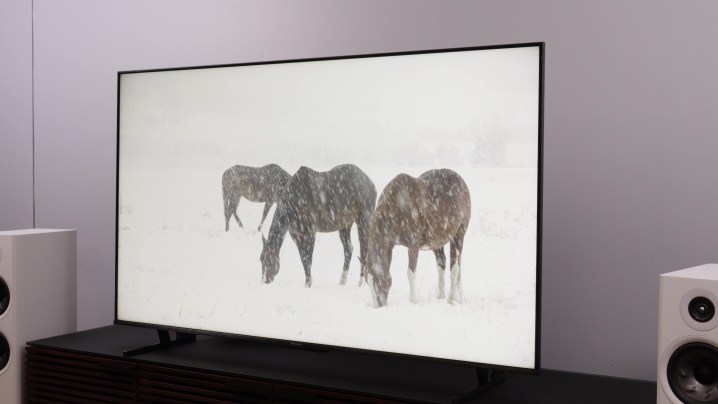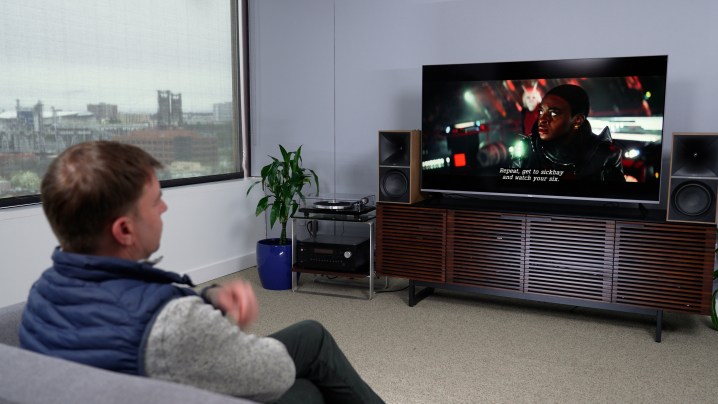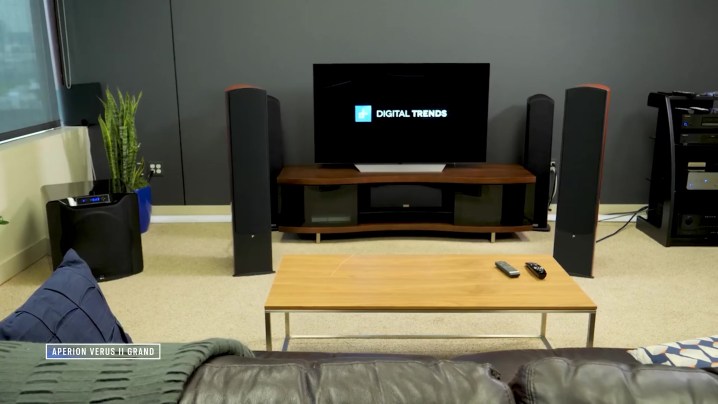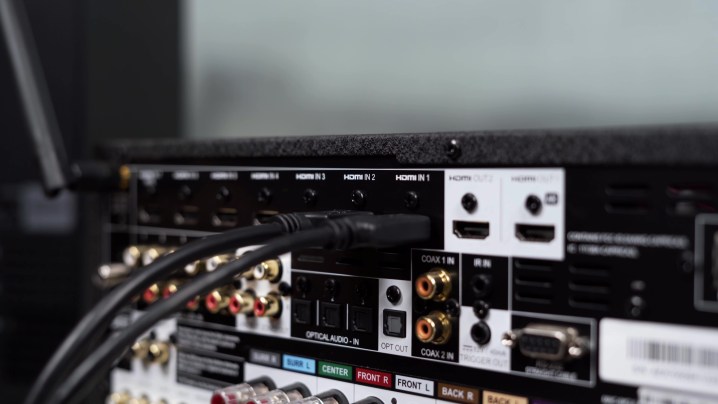You’ve got questions, I’ve got answers.
This is our first installment of a new series we’re calling “You Asked” because, well, many of you have asked me a lot of questions. And while I do my best to reply to them — in our YouTube comments, Instagram DMs, Twitter or … X or whatever it’s called, even via email — there is just not enough time in the day, week, month, year, decade, or what’s left of my lifetime to get to all of them.
The thing is, your questions are really good and pretty commonly asked as well, so I want to make space to answer them for you. Over the next several installments, I’ll try to cover some of the topics I get asked the most and will be the most helpful to you.
Motion smoothing and processing

Edward Lacombe (@elacombe75) asked: Hi Caleb, I’m pretty sensitive to motion artifacts on TVs and have always been driven to Sony in the past for this reason. However, these days I almost always stream in HD from Hulu (live tv), or from Disney+, Netflix, Amazon, etc. — no cable and no YouTube at all. Is video processing essentially a nonissue in this case? For purely HD streaming content, will the QM8 (for example) be just as good as a Sony?
Well, the short answer is no: The TCL QM8 will not be just as good as a Sony in that example. Lacombe mentions that he almost always streams in HD — and I imagine also streaming in 4K from some places and getting HDR, too.
But the higher resolution of those streams is only one element of picture quality for a TV’s processor. The issue with all streaming services, not just YouTube, is that the signal is compressed, and there will be missing information. This becomes most evident with large swaths of color on the screen; you’ll notice color banding when going from, say, a darker shade of green to a lighter one. The better the processing, the less color banding you will get.
Also, how a TV decides to handle brightness, how clean the image looks in general, there are a ton of other things the processor does to make even what seems like a high-quality source look its best. If all you ever watched was 4K Blu-rays, the processing between two TVs would still make a difference. It wouldn’t be as apparent, perhaps, but when it comes to streaming, take all the help you can get.
eARC connections

Question 2 came from @shukla91: I was wondering if it’s better to plug my HDMI devices directly into my TV or my receiver if I’m using an eARC connection, and what are the pros/cons of doing either one? Does it make a difference for gamers?
Great question! I get asked this one a lot. Purely for the sake of convenience, I’ll usually recommend folks connect everything to their TVs, and then run ARC or eARC back to their receiver or soundbar. This way, you are definitely going to get the least amount of lag for game consoles — even if it is a minimal improvement — and you have the convenience of everything that’s on the TV screen having audio come out of your audio device, whether it is built-in streaming services or some other device you’ve connected.
There are some exceptions though. If your TV and receiver don’t both support eARC, then it may not support the best available audio signals. For instance, Dolby Atmos would be delivered via compressed and slightly lossy Dolby Digital Plus versus lossless Dolby True HD — and I do think you can hear the difference. Also, if you have more devices than you have HDMI inputs, it may make more sense to use your AV receiver or preamp/processor as the hub. Also, there’s this issue where sometimes ARC just won’t work.
With that said, only recently have AV receivers started supporting HDMI 2.1 features, and they have been buggy as they’ve rolled out. That’s another reason I generally suggest using your TV’s inputs and outputting eARC to your audio device if you’re using next-gen consoles. Hope that helps!
Best TVs for bright rooms

Question 3 comes from @ayarpaton. If you were moving to a new place, where you need a nice TV for the living room with plenty of windows/light, would you go for an expensive brand TV or something along the lines of Hisense’s high-end TVs? What panel type, brightness, HDR tech, and HDMI tech would you prefer for said TV?
OK, so I think I understand when you mention an “expensive brand TV” versus something like the higher-end Hisense, and we can toss TCL and Vizio in there, too. You’re contrasting those brands against a Sony, LG, or Samsung I reckon. And then the other component of your question is around dealing with a living room with plenty of windows and light coming in.
I’ll address the second part first by saying that I feel like there’s this misnomer floating around that super-bright TVs will prevent you from a washed-out picture and reflections caused by lots of bright light coming into a room. Ultra-bright TVs will produce a better-looking picture in bright rooms than non-ultra-bright TVs. But the picture will always be a little washed-out, and reflections will always be there, no matter how good the antiglare treatment might be.
With that said, I think that there is an advantage to going with one of the more expensive brands when battling a bright room since they tend to have the best anti-glare technology. Samsung and Sony, in particular, have models that cut glare pretty well. But when it comes to raw brightness power?
Frankly, I’ll put one of the best TVs from Hisense or TCL, or one of Vizio’s top models, against Samsung and Sony any day. The real difference in pricing comes in other picture performance areas, as well as quality control. And I try to cover that stuff in the TV reviews.
TV brand reliability

Our next question came from @devinwaggoner702. Could you address the reliability of the various TV brands? I recently heard a podcast that said LG TVs are the brand that is most commonly returned at Best Buy.
First, let me say that it is hard for me to report on reliability as a reviewer because I so rarely get to test TVs for many years. I do keep in touch with friends and family to see how their TV brands and models are doing year after year. But that’s a small sample size, so any conclusions I draw would be too anecdotal. I do understand that reliability is important, and I feel like the best indicator for whether there is a widespread problem with a specific brand or a specific model is in discussion forums, which are a pain to comb through, but search engines can usually find you the info you’re looking for if you search the right way. Like, is the Brand X Model Y TV reliable? You’re likely to find out if there’s a whole group talking about how tons of them failed.
But be wary of statements like “this brand is most commonly returned at Best Buy.” First off, find out where that data came from and who is reporting it. If some dude says, “Yeah, I heard that” or “This guy I know that works at Best Buy said …,” immediately be skeptical. To poke holes in the statement, I’d want to know which were the top three models of LG TVs that were getting returned. I bet it wasn’t their OLEDs. And were those three models low-cost budget TVs? Or were they maybe the higher-end QNED TVs? And why were they returned? Was it because they broke within the return window, or did maybe folks decide they didn’t like WebOS or couldn’t figure out how to turn off the motion smoothing?
So – I can’t address the reliability of the TV brands unless I have firsthand experience with multiple failures of retail TVs, and even that would be isolated info. I think the court of public opinion will be the best judge on reliability. You need a large sample size to get meaningful data, and I just can’t do that.
Dolby Vision vs. HDR10

@zakstoiber1496 wrote: I want to see the Dolby Vision versus HDR10 comparison between competitor TVs like the S95c versus G3 or A95L (once it’s released).
Well, it’s not technically a question, but I’m sure glad that comment was posted because I think a lot of folks feel the same way, and that includes me!
I plan to do Dolby Vision in the Sony A95L versus HDR 10+ in the Samsung S95C, using the same panel technology, and balancing out as many other performance factors as possible. I think that’s the best way to do it. And you know what, I think we’re not going to see a ton of differences, and that the conversation is going to end up being about how the folks doing the HDR mastering of movies and TV shows are not taking enough advantage of Dolby Vision’s capabilities — and that’s the reason we’re not seeing much difference. But I’m ready to be surprised, and will definitely go in with an open mind. That is coming. But first, I have to get a Sony A95L, and I’m waiting just like everyone else. Also, growing impatient, but I digress.
Aperion Audio

The next one is just a fun one for me personally. @chrisbworth wrote: So, I use Aperion-powered Bluetooth speakers as my TV speakers. Anyway, I recently learned you used to work with them. Do you avoid reviewing their products because they don’t often put out anything new, or do you view reviewing them as a conflict of interest? Haha. or would it be awkward because you know you like other speakers better?
Well, I’m super curious to know how Chris learned that, not that it is a secret. Yes, I used to work at Aperion Audio, and that was a great time. I learned a lot there about audio on both the electronics and speakers side. So, I have reviewed Aperion products on the channel and will continue to do so as I can.
I do have to say that boutique speaker brands like Aperion are super fun and I like to do them from time to time, but I am SO busy with TVs that I have to pick my battles with speakers, and that’s why you’ll see me reviewing more commercial brands with bigger footprints like Sonos or Klipsch, KEF, B&W, Polk, Definitive Technology, etc. And, yes, at first, I did feel like there may be a conflict of interest there, but honestly, I got over that pretty quickly. And especially now, I mean, I left Aperion in 2008, so with 15 years of distance, there is no conflict there.
Receiver passthrough and picture quality

@2443Bobby asked: My receiver is about seven years old. Would upgrading to a current model have any impact on picture quality when using passthrough?
This question is a little tricky, but I’m going to do the best I can here. The term passthrough means the signal simply passes through, unaltered from the source. So if you’re actually using passthrough, then there should be no difference from one receiver to another except when it comes to certain combinations of resolution, HDR type, and, most importantly, chroma subsampling, which, at its most basic, is color information. Most 4K HDR signals can be passed through HDMI 2.0 and earlier, which maxes out at 18Gbps, but there are a few setups where you might actually need the higher bandwidth of HDMI 2.1. If you wanted 4K Dolby Vision with 10-bit or 12-bit color, I believe you would need HDMI 2.1 in your receiver to pass that along.
Here’s the more important thing I want everyone to take away: From your Blu-ray player to your streaming box to your AV receiver or even preamp/processor, it is a very, very rare case in which any of those devices would have a better video processor than what’s built into your TV. There are very rare exceptions to that – and if you know better, then you know enough not to need the answer to this question. But, your AV receiver doesn’t need to be doing anything with the video signal — it should just pass it along. In fact, I think it’s worth going into your AV receiver and turning video processing off if it is turned on.
Editors’ Recommendations
Services Marketplace – Listings, Bookings & Reviews